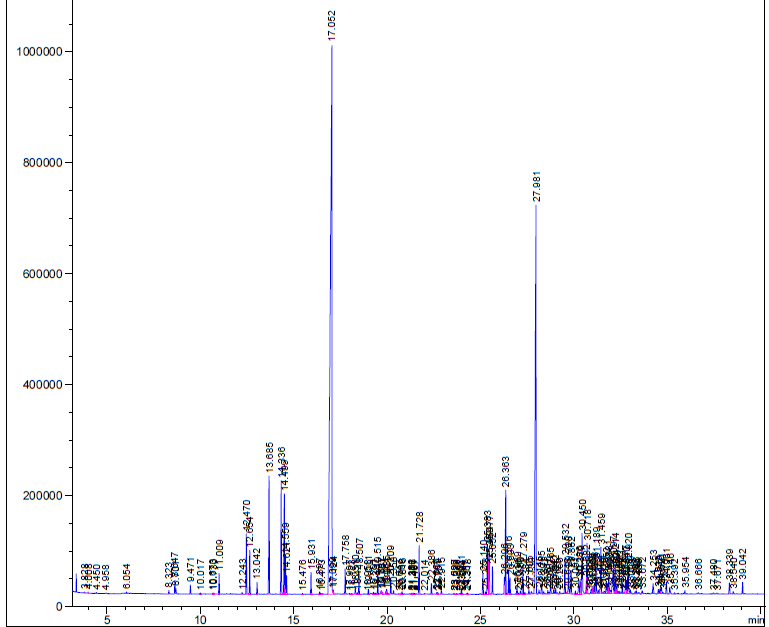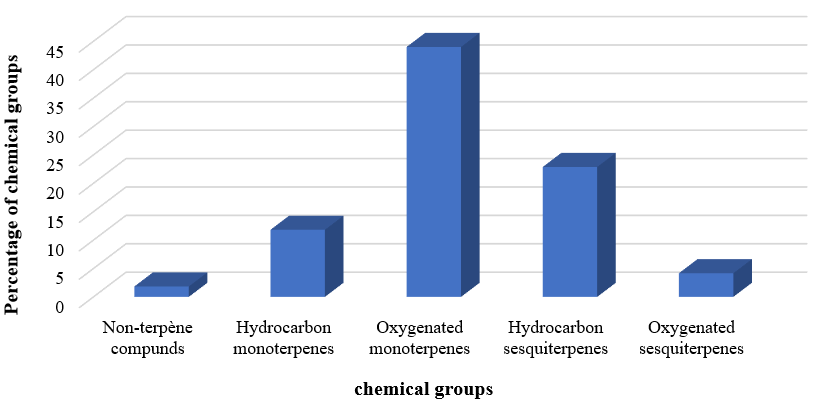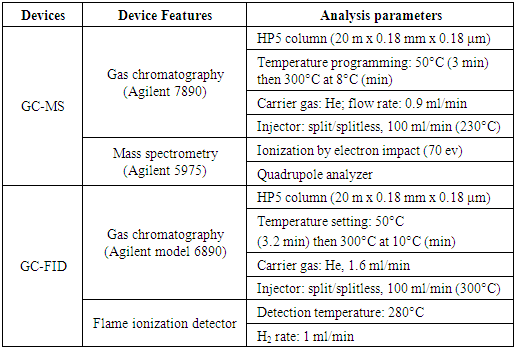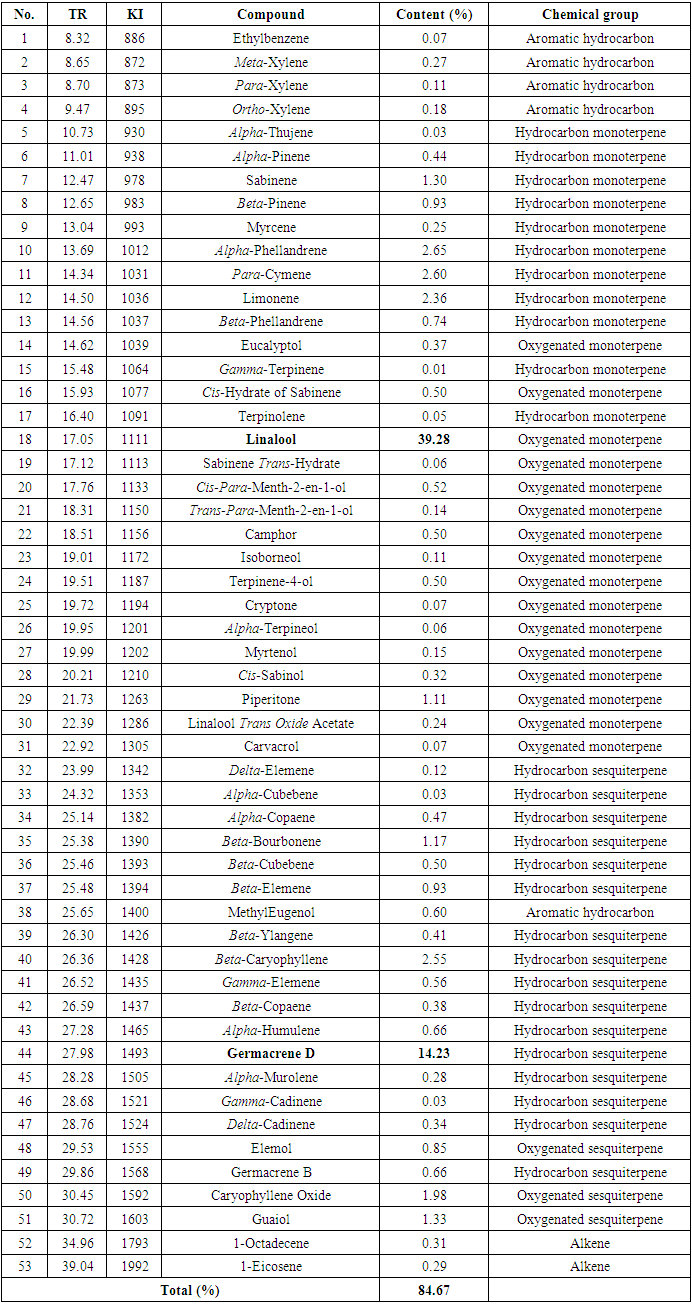-
Paper Information
- Paper Submission
-
Journal Information
- About This Journal
- Editorial Board
- Current Issue
- Archive
- Author Guidelines
- Contact Us
American Journal of Chemistry
p-ISSN: 2165-8749 e-ISSN: 2165-8781
2025; 15(2): 43-49
doi:10.5923/j.chemistry.20251502.02
Received: Apr. 18, 2025; Accepted: May 14, 2025; Published: May 30, 2025

Chemical Composition of the Essential Oil of Piper guineense Schum. & Thonn. Fruits from the Republic of Congo
Célestine Nkounkou Loumpangou1, 2, 3, Beni Franck Madzou Mbani1, Sévère-Grébel Babouongolo1, 3, Longin Justin Clair Bonazaba Milandou1, Kevin Bikindou2, Jean-Maurille Ouamba1
1Plant and Life Chemistry Unit, Faculty of Sciences and Techniques, Marien NGOUABI University, Brazzaville, Congo
2Normal Superior School, Marien NGOUABI University, Brazzaville, Congo
3Faculty of Applied Sciences, Denis SASSOU-N'GUESSO University, Brazzaville, Congo
Correspondence to: Célestine Nkounkou Loumpangou, Plant and Life Chemistry Unit, Faculty of Sciences and Techniques, Marien NGOUABI University, Brazzaville, Congo.
| Email: |  |
Copyright © 2025 The Author(s). Published by Scientific & Academic Publishing.
This work is licensed under the Creative Commons Attribution International License (CC BY).
http://creativecommons.org/licenses/by/4.0/

The fruits of Piper guineense Schum. & Thonn. are used in traditional medicine to treat several diseases and in African cuisine as a spice to flavor culinary preparations. The extraction of essential oil from the fruits of the Congolese plant species was done by hydrodistillation. The results of analysis of this oil by GC/MS and GC/FID showed a total of 53 compounds. Oxygenated monoterpenes (44%) and hydrocarbon sesquiterpenes (22.87%) are the most dominant in this essential oil. Linalool (39.28%) and Germacrene D (14.23%) are the majority in this oil. The presence in this oil of these compounds as well as alpha-phellandrene (2.65%), para-cymene (2.60%), beta-caryophyllene (2.55%), limonene (2.36%), caryophyllene oxide (1.98%) and piperitone (1.11%) is very important; because they have several applications in the food and pharmaceutical industry. This richness in compounds shows that Piper guineense fruits are plant organs to consume to ensure the health of the body.
Keywords: Piper guineense, Essential oil, Fruits, Congo
Cite this paper: Célestine Nkounkou Loumpangou, Beni Franck Madzou Mbani, Sévère-Grébel Babouongolo, Longin Justin Clair Bonazaba Milandou, Kevin Bikindou, Jean-Maurille Ouamba, Chemical Composition of the Essential Oil of Piper guineense Schum. & Thonn. Fruits from the Republic of Congo, American Journal of Chemistry, Vol. 15 No. 2, 2025, pp. 43-49. doi: 10.5923/j.chemistry.20251502.02.
Article Outline
1. Introduction
- Since ancient times, plant materials with intense and varied flavors have been used for food and medicinal purposes. They are generally known for their flavor profile, particularly their aromatic properties. These plants are commonly used as seasonings (spices) in cooking due to their ability to enhance flavor, thus playing an important role in the food industry [1]. In addition to their nutritional and aromatic values, spices also constitute a good resource for use in medicine and cosmetic products [2]. Among the spices, Black pepper (Piper nigrum L.) is the most used spice in the world, which gives it the name “king of spices” [3]. At the origin of the aromatic character of spices are volatile compounds called essential oils [4]. Essential oils, consisting mainly of terpene and phenolic compounds, are widely used as flavorings in food as well as in medicine due to their antimicrobial, antioxidant, antibacterial, antifungal, antiviral, anticancer properties, etc. [5,6].In certain African countries, in the Republic of Congo in particular, a species of the piper genus named Piper guineense Schum. & Thonn. is widely used by populations for their food and health needs. Indeed, Piper guineense is a climbing herbaceous plant in the Piperaceae family. It is commonly found in African tropical forest areas [7]. These seeds are used as spices by the Congolese population [8]. In traditional African medicine, these organs are used in the treatment of rheumatism, bronchitis, cough, gastric disorders, intestinal diseases, gonorrhea, obstetrics and improving fertility in women, weight control and obesity, mental illness [8-10]. Chemical metabolites, including proteins, carbohydrates, lipids, terpenes, polyphenols and alkaloids, present in the plant give it its flavoring character and are responsible for several biological properties (antioxidant, anti-inflammatory, antimicrobial, antifungal, etc.) [11-13].Natural products, particularly spices, are increasingly renowned for their powerful beneficial effects on health, both nutritionally and medicinally; they can therefore play a role in reducing the use of synthetic seasonings (nutrients) and medicines [8]. With the aim of contributing to the valorization of natural nutrients (spices) used by the Congolese population, this present work was undertaken to determine the chemical composition of the essential oil of Piper guineense fruits.
2. Material and Methods
2.1. Plant Material
- Piper guineense fruits were collected in Zanaga district of the Lékoumou department (Republic of Congo) in August 2023. This plant was identified by botanists from the National Herbarium of Congo where the species is recorded under number 164. The harvested plant material was dried at room temperature in a ventilated room for 3 weeks then crushed.
2.2. Extraction of Essential Oil from Piper guineense Fruits
- The extraction of the essential oil from this plant was done using a Clevenger extractor. Therefore, 250 g of crushed dry fruits of the plant were put in a 6l flask containing 3l of distilled water and subjected to hydrodistillation for 3 hours. The yield of essential oil obtained was determined by a mass ratio between the oil obtained and the dry plant material used.
2.3. Analysis of the Essential Oil of Piper guineense Fruits
- The analysis of this essential oil was carried out by gas chromatography coupled with mass spectrometry (GC/MS), on the one hand, and by gas chromatography coupled with a flame ionization detector (GC/FID), on the other hand. The analytical conditions of the essential oil are summarized in Table 1.
|
2.4. Identification of Compounds
- Chemical compounds in this oil were identified using Adams 2012, LEXVA analytical, Wiley and NIST databases.
3. Results and Discussion
3.1. Extraction Yield of Essential Oil from Piper guineense Fruits
- Piper guineense fruits provided an essential oil yield of 0.25%. This yield found is within the range of yields of species of the genus Piper. The value of 0.25% obtained is close to that (0.2%) obtained on the same organs of the Cameroonian species [14]. However, it is higher than the yield (0.09-0.17%) obtained with the fruits of the Ivory Coast species and lower than those produced (0.45% and 1.2%) respectively by the fruits of the Nigerian and Liberian species [12,15,16]. Furthermore, the extraction of essential oils from the different species of Piper cited in the literature gave variable yields; this is the case of essential oils obtained from Piper nigrum L. (1.11%), Piper cubeba L. (1.23%) and Piper umbelatum L. (0.02%).The difference in yield, from the same species or botanical family and from one organ to another, in essential oil can be due to several factors such as the origin of harvest of the species, the harvest period, the species of the plant, the organ of the plant, the method of extraction, etc. [18,19].
3.2. Chemical Composition of the Essential Oil of Piper guineense fruits
- The analysis results identified a total of 53 compounds representing 84.67% of the compounds in the essential oil of this Congolese plant species, divided into 5 chemical families, namely: hydrocarbon monoterpenes (11.81%), oxygenated monoterpenes (44%), hydrocarbon sesquiterpenes (22.87%), oxygenated sesquiterpenes (4.16%) and non-terpene compounds (1.83%) such as alkenes and aromatic hydrocarbons (Figure 1, Table 2). In terms of compound diversity, of the 53 compounds identified, there are 11 hydrocarbon monoterpenes (21%), 16 oxygenated monoterpenes (30%), 16 hydrocarbon sesquiterpenes (30%), 3 oxygenated sesquiterpenes (6%) and 7 non-terpene compounds (13%) (Table 2).
|
 | Figure 1. GC/FID chromatogram of the essential oil of Piper guineense fruits |
 | Figure 2. Distribution of the main classes of compounds in the essential oil of Piper guineense fruits |
4. Conclusions
- The present work was devoted to the identification of the chemical compounds present in the essential oil of fruits of Piper guineense Schum. & Thonn. of the Republic of Congo. The extraction of this oil gave a yield of 0.25%, appreciable compared to certain results from other countries. The chemical analysis of this oil from the Congo species showed some profile rich in chemical compounds, almost half of the compounds identified were not identified by several works on the same species. Linalool and Germacrene D are the two major compounds and could be responsible for the biological and aromatic properties of this plant. The Piper guineense species from Congo, which is used all the more by the population in traditional medicine and in food, can also be valued as a spice given its richness in aromatic compounds to enhance the flavor of dishes.
ACKNOWLEDGMENTS
- The authors thank all the people and structures who were involved in carrying out this work.
CONFLICT OF INTEREST
- The authors declare that they have no conflict of interest with any third party.
 Abstract
Abstract Reference
Reference Full-Text PDF
Full-Text PDF Full-text HTML
Full-text HTML
